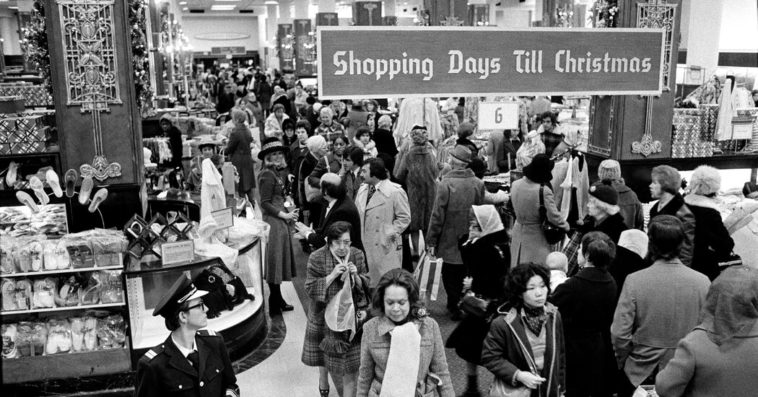The Loneliness of One-Click Shopping – The New York Times

One December day in 1991, a woman walked into a Bon-Ton department store in Ithaca, N.Y., in a state of high anxiety. Christmas loomed and she had yet to purchase a single gift. A clerk devoted herself to the customer’s cause, moving through the store with her to select something for each person on her extensive list.
The clerk’s tale became something of a legend at the Bon-Ton, a regional chain that grew to include 262 stores across the Northeast and Midwest. The company prided itself on the customer service that had characterized it from the start, a century earlier. It is a consumer experience that we are now at risk of losing altogether, as our buying habits shift away from our local stores and into the ether.
Nationwide, 9,800 stores shuttered in 2019, among them 2,500 Payless ShoeSource stores and 220 Sears stores. That was the highest level on record, but it has been outdone by the devastation of this pandemic year. Americans who might once have felt qualms about buying from Amazon now have social license to do so — it has become our patriotic duty, our cause larger than ourselves, to fulfill our needs online. By placing a one-click order, we have been helping to flatten the curve.
In the third quarter of this year, Amazon’s sales were up more than a third over the year before, with profits surpassing $6 billion. To handle this surge and prepare for holiday season demand, the company hired 250,000 people between July and September, pushing its global work force past one million. Analysts predict that brick-and-mortar store closures could reach 25,000 by year’s end. J.C. Penney, Neiman Marcus and J. Crew filed for bankruptcy, Macy’s furloughed nearly all of its 125,000 workers for months, and countless independent businesses have closed for good.
By its end, the pandemic may have permanently reshaped national spending habits. A recent McKinsey & Company survey found that more than half of consumers plan to keep using curbside pickup and grocery delivery after the pandemic is over. Many storefronts will remain abandoned. Those who once worked in them — since 2012, no other occupation has shrunk more in number than retail salesperson — will head for the order-fulfillment centers proliferating across the country; Amazon opened 100 sorting facilities and distribution centers in September alone. Such work often pays less than what a veteran retail clerk would normally make, and is more physically taxing and far more socially isolating.
The shift will also increase the divide between countless struggling cities and towns and the flourishing metropolitan areas now home to the headquarters of the online giants. Amazon recently announced plans to build office space for 25,000 salaried employees in Bellevue, a high-end Seattle suburb. In Arlington, Va., work proceeds on a new campus that will also welcome 25,000. In New York, the company paid $1 billion to gather 2,000 professional employees in, of all places, the former Lord & Taylor flagship store on Fifth Avenue.
The Bon-Ton, by contrast, had from the start set out to serve smaller cities, making its demise, in 2018, an especially stark example of the twin problems of growing regional inequality and economic concentration.
The company’s roots traced back to the final years of the 19th century, when Samuel Grumbacher, a dry-goods merchant in Trenton, N.J., and German immigrant, sent his two sons and two sons-in-law off to stake out territory in the small cities of Pennsylvania. In 1897, his son Max wrote to his father from York, a thriving manufacturing town south of Harrisburg, “I think we will do a good business here.”
He was right. The Bon-Ton offered an aspirational allure to the people of York. The Grumbachers sold fabrics on the bolt, with clerks ready to assist with cutting and measuring and a deliveryman ready to carry home large orders by horse and wagon. But it was in hats that Max Grumbacher distinguished his shop. Each season, he brought two milliners from New York to produce designs in the latest styles to be adopted by the shop’s own milliners. Hats were trimmed free.
By 1912, the shop had moved into a resplendent new building, a four-story terra-cotta extravaganza with 27 departments spread across 37,000 square feet (bedding and housewares, stationery, cloaks and suits, corsets). Elevators were operated by smartly clad women; the mezzanine tearoom became a central meeting place. Musicians entertained shoppers on Friday and Saturdays. And every Christmas season, the store installed elaborate window displays and hosted a parade that culminated with Santa Claus being lifted over the crowd on a hook-and-ladder fire truck.
This was America’s golden era of department stores, when the average visit by shoppers lasted an astonishing two hours: New York had, among others, Lord & Taylor and Bloomingdale’s, Chicago had Marshall Field, Philadelphia had Wanamaker’s. The Grumbacher family’s bold premise was that a small city like York deserved such bounty, too. The shoppers agreed.
The Bon-Ton expanded into many other small cities as the company was passed down to Max’s widow, Daisy, and his sons Tom and Richard. Among them were Hanover, Pa; Hagerstown, Md.; and Martinsburg, W.Va. Later, as suburban flight set in, stores opened in malls and shopping centers. In 1991, Tom’s son Tim took the company public, helping fuel further expansion.
Throughout the growth, the company retained a personal touch. It was famously lenient in its return policy, according to a commemorative history issued on its 100th anniversary. A “Charity Day” preceded store openings, when local groups could sell tickets for a preview visit. Stores offered fashion seminars and held champagne receptions for new product lines.
The end came startlingly swiftly. Struggling under the debt of its expansion, the company tried its best to adapt to the rise of e-commerce. But those champagne receptions didn’t translate to the virtual world, and it was impossible to compete with a giant like Amazon, which had capitalized on advantages such as skirting sales taxes in many states and getting bulk discounts from the Postal Service. The Bon-Ton declared Chapter 11 bankruptcy in early 2018 and closed its stores that summer. A tech firm later purchased the brand for its e-commerce sites.
Last year, I went to York to meet with Tim Grumbacher and his wife, Debra Simon, who succeeded him as company chairman when he retired. The old flagship store with its terra-cotta facade now holds the county’s human-services offices: adult probation, the drug and alcohol commission, mental-health case management. When I told the deputy sheriff working security why I was there, he regaled me with recollections from his childhood, of the pretty women in the cosmetics department, of being told, when he didn’t know what size socks he needed, to ball up his fist for a proxy measurement.
Over lunch at a Panera, I asked Mr. Grumbacher and Ms. Simon what had come of the three Bon-Tons in the York suburbs. They struggled to agree on what remained at the former site of one of them, the Galleria mall, most of which was now empty.
“And Penney’s,” Mr. Grumbacher said.
“Penney’s is gone,” Ms. Simon said.
“Kohl’s,” he said. “Who’s at the other end?”
“It’s empty,” she said.
Last summer, my older son’s baseball tournaments often took us to the small cities of Pennsylvania. It seemed as if on each trip, we would pass yet another abandoned Bon-Ton — in Lebanon, in Harrisburg, in Allentown. Each time, I would think about that Ithaca clerk coming to the aid of the frantic Christmas shopper, and of the gratitude and social warmth of human consumer experiences.
That clerk’s modern counterpart might be a woman in one of the nearby fulfillment centers, rushing to keep up with the picking and packing of the orders we are now placing from the safety and comfort of home with barely a notion of the people involved in delivering our wish to our door. Something, I realized, has been lost in that transition.
Alec MacGillis is a senior reporter at ProPublica and the author of the forthcoming book “Fulfillment: Winning and Losing in One-Click America.”
The Times is committed to publishing a diversity of letters to the editor. We’d like to hear what you think about this or any of our articles. Here are some tips. And here’s our email: letters@nytimes.com.
Follow The New York Times Opinion section on Facebook, Twitter (@NYTopinion) and Instagram.
Published at Fri, 27 Nov 2020 10:00:00 +0000





Comments
Loading…